CN7023 Assignment Sample – Artificial Intelligence & Machine Vision 2022
1.0 Introduction
Image classification is a method of classifying various kinds of images into different classes or groups in order to identify those images very easily. This classification of images can be used in different sectors for easy understanding of the situation and how they can be implemented for performing the required analysis and solving any critical problem which is mainly involved with image or picture. Now image classification is a complex task that cannot be taken as easy as it is thought in many cases.
The classification of images depends on numerous factors like the type of an image, resolution of it, overall size of it and so on. These criteria are to be used mainly to perfectly classify the images of any given set of images data. Now the classification of images can be done based on various methods. Most of the methods that are used for performing the classification of an image are complex.
A neural network is one of the important methods of classification operation that is sometimes used for classification. Now in the current study, the classification of medical images has been implemented using neural networks. In the whole study, the classification operation is done based on the spots inside of the images and their resolutions.
1.1 Image classification
The image classification concept can be applied in different cases to understand the types of various images that are taken in the datasets (Kayabası and M 2017). Mainly the classification of images can be treated as a mapping technique that is used to map the data from input to output.
The input is a set of numeric data, and the output is the symbol, or it may be vice versa. It has the main importance in case of identification of the images of signatures made by different people, in order to understand the nature of a facial expression of a human being, to understand the height of different persons and so on. Now the classification operation is to be performed very carefully based on the characteristics of those images.
This operation provides the users for getting the reliability of the data that can be extracted from the image data. Now for performing the overall classification operation, a detailed analysis is required. This analysis will be very important, and it will be critical.
As shown in the above figure 1, the data classification based on the nature of the internal content of images can be identified and classified in the above way. This classification is based on certain features of the images that are selected.
1.2 Image classification method
Before proceeding to the image classification, it is the prime factor to know what image classification method. There are several methods that can be utilized for the overall classification of various images (Fathizadeh and S.R. 2020). In this context, KNN classifier, Decision tree, K-mean classifier and so on are the most critical as well as important methods that can be successfully applied for the detailed classification of the overall image. Now the main problem is that which classification method can be chosen for perfect classification operation depends on the nature of the problem that has been addressed here, complexity of the images and so on.
ANN or the neural network-based classification is one of the most critical and popularly applied methods for successfully classifying various types of images. SVM or the support vector machine is another method that can be applied for classification of images. Now there are several advantages as well as disadvantages between the various techniques that are used mainly for performing the classification operation of images.
If three consecutive methods can be taken for initiating the classification operation, then the SVM can be taken in the top as due to its higher advantages due to high level of impact on the perfect image classification. This method has the only advantage that it can be applied very efficiently in case of complicated situations where all the images are not specified as easily as possible and contain hessiness. Others can be applied, but the most popular method is the neural network-based application.
1.3 Concept of neural network
A neural network is a network that can be constructed based on the connection of a series of nodes with each other. These nodes are similar to the various nodes present in the human brain or most popularly known as the neurons. These neurons are the critical and the smallest part of the human brain (Wadkar and N 2019). After the series of connections established between the different nodes or the neurons of a neural network, the overall network can be implemented for different operations.
Here in the above figure 2, the basic structure of an artificial neural network has been shown. This is the basic model for the overall development of the complete network. Clearly from the above figure, the model consists of two different layers. These are the input and the other is the output layer (Wang and L 2017).
As shown from the figure, there is a set of features which can be taken as the set of inputs to the overall network. The network generally operates based on the nature of the inputs that are coming to the network. The net signal that has been generated and shown in the above figure can be represented as below-
Yin=w1*x1+w2*x2*w3*x3+……..wm*xm
Output=f(Yin)
Finally, the output can be obtained as the function of the net signal represented by Yin.
Now, after coming to the network, all the inputs are to be summed up for creating a single input. This single input is also known as the net signal. This net signal goes to the next part of the system. The next part of the system is known as the output layer where the summed up signal or the net signal is used to pass through a function.
This function is commonly known as the activation function. This function may be of different types like linear or nonlinear. Now, based on the operation and the function that has been used here for performing the activation and generating the signal that will be transmitted to the output.
1.4 Concept of learning
The learning or the training is the most critical method that is used for developing a critical problem and solving the various types of critical problems that can be raised in real life (SANDHIYA and Y 2018). Now before going into the depth of the learning operation of a neural network, the base of the learning and how learning can be implemented for perfectly training a network has to be familiarized.
Mainly the training of an ANN means the adaptation or updation of weights of the network. These weights are the associated factors that can be taken before giving the actual throughput to the overall system. These weights can be taken in the numerical numbers and can be considered aunty real numbers that can be associated with the input datasets before final entry to the network. In the above figure, the weights are denoted by the letter W and it can be represented by the matrix which can be presented in the below section-
W=[w11, w12, w13,……..w1n
Wm1…………………….wmn].
The relation in the above can be treated as a matrix, and it can be formed as a square matrix or a rectangular matrix. The overall training performance mainly depends on the updating operation or the adaptation of the various weighting factors as shown in the above figure. It has been critically justified that the weight adaptation process is the main part of the overall training operation.
1.5 Supervised learning
There two types of learning of a neural network mainly persist. These are the supervised as well as unsupervised learning methods. Now among these two types of learning operations, the supervised learning operation is the key factor and can be utilized in most of the cases for perfect training of the network that has been considered for training.
The main working principle of supervised learning is that, in this case, a set of training data sets is provided as the set of features or the inputs (Zhang and Q 2018). And the error is generated based on the perfect application of the overall process.
As shown in the above figure 3, the operation of the supervised neural network is totally based on the structure that has been considered here. Clearly shown in the above figure, there is a set of inputs that are coming to the input layer of the ANN considered. Now the problem is that the overall network structure may be any type, and that depends on the overall complexity of the operation and the technique of learning that will be applied for overall training of the network (Cao and S 2017).
Mainly the overall network may be classified according to its various structures. These classes are the feed forward network, feedback network, feedback network with self loop and so on. at every iteration. Now how much iteration it requires, it can be determined by the complexity of the problem and the error magnitude and the specified limit of the error.
1.6 Unsupervised learning
Unsupervised learning is completely programmed by computer. This learning is based on pixels. The process is completely programmed, but a very minimal amount of input can be controlled by the user (Sun and J 2020). There are some benefits as well as disadvantages of this learning. The process is quick in this learning. But its classification needs time. There are many kinds of learning methods.
2.0 Methodology
There are many kinds of methods that are involved in the classification of the images. They are as follow-
2.1 Segmentation of image
Neural networks can be designed using many different steps. This is a process where the images are being divided into smaller segments. This is one of the most vital parts for this process. Input image is being identified by this method. This method also helps to calculate the actual size and shape of the image.
Similar pixel images are being categorized in the process of this segmentation(Ju and M 2018 ). The image segmentation basically implies the critical classification of an image based on the pixel values as obtained. It is the masking operation of an image based on its pixel values. This process basically helps to identify each of the part of the image that is under the segmentation.
2.2 Image classification based on neural network
The study of machine learning is a part of science. It deals with the study of a complex structure in such a way that the human brain works. “Biological neural networks” get impacted by the “artificial network”.
A neural network consists of many layers. It mainly consist of # layers. The name of those 3 layers are as follows-
- An input layer, 2. Hidden layer, 3. Output layer
The layers thatare present if there is more than one. Then the layer is known as a deep “neural network”. On the other hand, the layer between the input layer and the output layer is called the hidden layer. The work of the hidden layer is that it takes all the data of the input layer and then it transmits the data to another layer which is known as the outer layer.
In “neural network”, the term training refers to the “data level” information that is being collected (Sun and G.G 2019). All the information from the collective data is required to make a “machine learning” model. When any network that is being designed for an application is ready to learn. There are two different methods to train a network.
2.3 The back propagation training
Several steps are involved in the “back propagation” process. The term “propagation” means to transfer something in a given direction. The things that can be transferred to a particular direction are light, sound etc. These can be transferred to a particular direction. Transmission of data is the most important thing in this training method. Any kind of untrained networks are taken as immature networks (Wang and X 2017).
On the other hand, any network that is properly trained is known as a mature network. Basically this training acts as a messenger. The steps that are involved in “back propagation” training are- 1. Forward propagation, 2. Backward propagation and then by putting all values together and calculating the “weight value”.
3.0 Simulation
Here in the above, a detailed study has been made regarding the image classification based on the proposed method. Now all these methods are implemented using the software MATLAB. All the results are presented in the below section-
After loading the image data into the software, the picture of the images is obtained as the output. Here the images that have been chosen are the images of the abdomens. These images are taken for performing the medical surgery(Haut and A 2018). Now the simulation results have been presented here-
As shown in the above figure, the picture consists of a total of three pictures of the abdomens. Now all these pictures are concatenated with each other to represent the images.
Now after loading the class 1 data for the images, the class 2 is also loaded, and the output of simulation is obtained as presented in the above.
Now all these images are to be segregated as per the proposed structure of the problem. Again the testing images are to be loaded here and used to perform the required operation.
Now after performing the trained image can be used to compare with the test image also. The test image is presented here. As shown in the above figure, the test image of class 1 is presented.
As shown in the figure 8, the figure depicts the class 2 test images.
4.0 Result obtained
The results of the simulations can be presented in the below section-The overall network that has been considered here is the patternnet due to perform the classification operation as simply as possible.
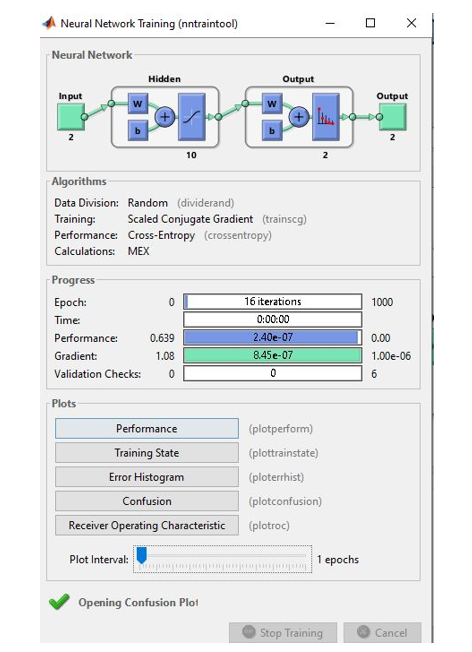
Figure 10: Output of simulation (Platform of training)
(Source: MATLAB)
The platform of the training is shown in the above. This shows that the network takes a total of 16 iterations.
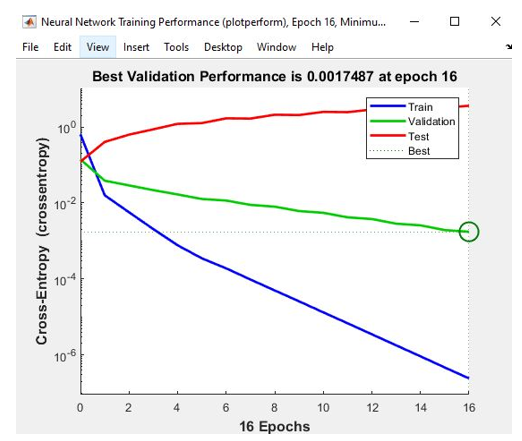
Figure 11: performance
(Source: MATLAB)
Performance is shown here that the validation meets the best performance.
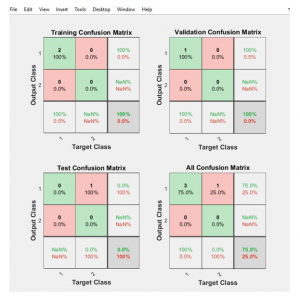
Figure 12: Confusion matrix
(Source: MATLAB)
4.0 Critical analysis
From the above test, the results that have been provided and talked about can be analyzed more to get a full idea to obtain a full classification of the data set. Pattern recognition problem has been discussed here. And this problem is completely based on the details of performance analysis and classification. As per the study, only two classes where choose that need to be done classification and in every class 4 images were taken. Here in the analysis , the pattern recognition network has been considered to classify all the images(Mayannavar and V.M 2020).
The most important criterion of classification that is chosen in this project was the color of the apples. The class separation that has been taken can be put as critically justified up to some point. In the main problem, there are two classes are considered for detail classification. Now in order to feed the images into the network for classification, they are to be coded into different numerical values.
The above mentioned network has been taken as the most important system which can effectively manage the overall performance of the system in classification problem in all respect. The problem that has been performed here is the most critical case of data classification. By observing the results various critical aspects can be represented here for in depth analysis.
The results that are obtained here are depended on the critical classification problem. As per the figure 10, the platform of the training is obtained where the well known training function is adopted for performing the training operation. Overall 16 iterations can achieve the desired result. The performance plot shown in figure 11 indicates that there are three parts. All these parts are obtained in the plot and the best point is achieved at the respective point.
Now the confusion matrix shows the detail classification and indicates the classification error. As per the mentioned case, the detail classification can be modified as per the inherent property of the model. Now if the numerical values or the quality of the figure is to be changed, the parameters of the model can be adjusted.
5.0 Conclusion
In the above assignment, for the classification of image two groups of images have been taken. Now those two groups of images have their own four sets of images which need to be classified. Now the four images of the two groups have been classified. The four images have been selected and they have been trained.
The process that has been used to train these images are known as “feedforward” or “patternet”. The term backward propagation is a method to train classification and this method was taken into consideration. The backward propagation falls under the neural network.
The classification of the image was done using the software called “Matlab”. In this assignment, the knowledge about the “neural network” has been done. In this project the classification of the images has been mentioned and it has also been mentioned how the backward propagation has been used to classify the images. This backward propagation comes under the “neural network”.
Reference List
Journals
Cao, F., Yang, Z., Ren, J., Ling, W.K., Zhao, H. and Marshall, S., 2017. Extreme sparse multinomial logistic regression: A fast and robust framework for hyperspectral image classification. Remote Sensing, 9(12), p.1255.
Deepa, R. and Vembandasamy, K., DIABETIC PREDICTION AND CLASSIFICATION USING ANN WITH ANFIS_BPNN.
Fathizadeh, Z., Aboonajmi, M. and Hassan-Beygi, S.R., 2020. Classification of Apples Based on the Shelf Life Using ANN and Data Fusion. Food Analytical Methods, pp.1-13.
Haut, J.M., Paoletti, M.E., Plaza, J., Li, J. and Plaza, A., 2018. Active learning with convolutional neural networks for hyperspectral image classification using a new bayesian approach. IEEE Transactions on Geoscience and Remote Sensing, 56(11), pp.6440-6461.
HK, S. and VEERABABU, A., SEGMENTATION, DETECTION AND CLASSIFICATION OF BRAIN TUMOR MRI IMAGES USING ANN.
Ju, C., Bibaut, A. and van der Laan, M., 2018. The relative performance of ensemble methods with deep convolutional neural networks for image classification. Journal of Applied Statistics, 45(15), pp.2800-2818.
Kayabası, A., Yildiz, B., Sabanci, K., Yigit, E., Toktas, A. and Tekbas, M., 2017, August. Colour feature-based classification of wheat grain using ANN with bayesian regularization learning algorithm. In 3rd International Conference on Science, Ecology and Technology (ICONSETE) (pp. 14-16).
Mayannavar, S., Wali, U. and Aparanji, V.M., 2020. A Novel ANN Structure for Image Recognition. arXiv preprint arXiv:2010.04586.
Priyadarshini, P. and Malik, C.D.O., 2017. Image Classification For SAR Images Using Modified ANN.
SANDHIYA, S. and Kalpana, Y., 2018. A SEGMENTATION AND VERIFICATION OF LUNG NODULE IMAGE IDENTIFICATION USING ANN. International Journal of Computer Science and Information Security (IJCSIS), 16(11).
Sultana, F., Sufian, A. and Dutta, P., 2018, November. Advancements in image classification using convolutional neural network. In 2018 Fourth International Conference on Research in Computational Intelligence and Communication Networks (ICRCICN) (pp. 122-129). IEEE.
Sun, Y., Xue, B., Zhang, M. and Yen, G.G., 2019. Evolving deep convolutional neural networks for image classification. IEEE Transactions on Evolutionary Computation, 24(2), pp.394-407.
Sun, Y., Xue, B., Zhang, M., Yen, G.G. and Lv, J., 2020. Automatically designing CNN architectures using the genetic algorithm for image classification. IEEE transactions on cybernetics, 50(9), pp.3840-3854.
Wadkar, K., Pathak, P. and Wagh, N., 2019. Breast cancer detection using ann network and performance analysis with SVM. International Journal of Computer Engineering and Technology, 10(3), pp.75-86.
Wang, F., Jiang, M., Qian, C., Yang, S., Li, C., Zhang, H., Wang, X. and Tang, X., 2017. Residual attention network for image classification. In Proceedings of the IEEE conference on computer vision and pattern recognition (pp. 3156-3164).
Wang, J. and Perez, L., 2017. The effectiveness of data augmentation in image classification using deep learning. Convolutional Neural Networks Vis. Recognit, 11.
Zhang, M., Li, W. and Du, Q., 2018. Diverse region-based CNN for hyperspectral image classification. IEEE Transactions on Image Processing, 27(6), pp.2623-2634.
Zhu, F., Li, H., Ouyang, W., Yu, N. and Wang, X., 2017. Learning spatial regularization with image-level supervisions for multi-label image classification. In Proceedings of the IEEE Conference on Computer Vision and Pattern Recognition (pp. 5513-5522).
Appendices
Appendix 1:
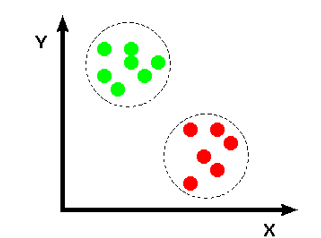
Figure 1: Image classification example
(Source :Homepages.inf.ed.ac.uk)
Appendix 2:
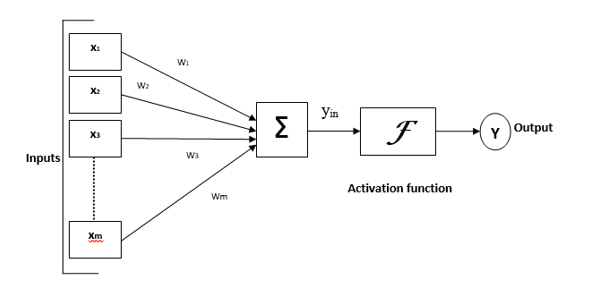
Figure 2: The basic structure of an ANN
(Source: https://www.tutorialspoint.com/)
Appendix 3:
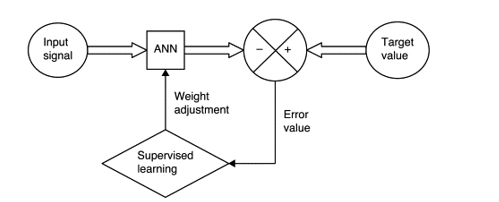
Figure 3: Supervised learning
(Source: https://www.tutorialspoint.com/)
Appendix 4:
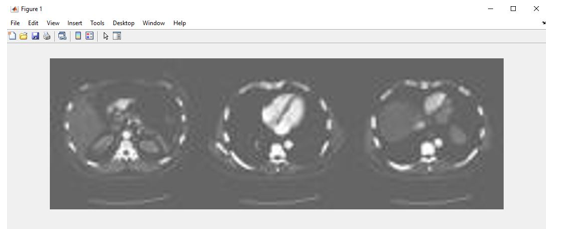
Figure 5: Output of simulation (Picture of class 1 image)
(Source: MATLAB)
Appendix 5:
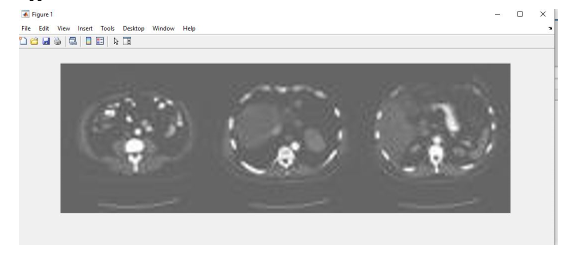
Figure 6: Output of simulation (Picture of class 2 image)
(Source: MATLAB)
Appendix 6:
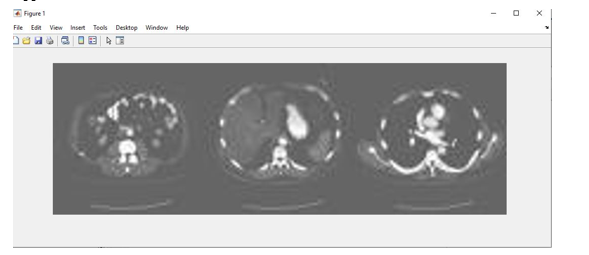
Figure 7: Output of simulation (picture of class 1 test images)
(Source: MATLAB)
Appendix 7:
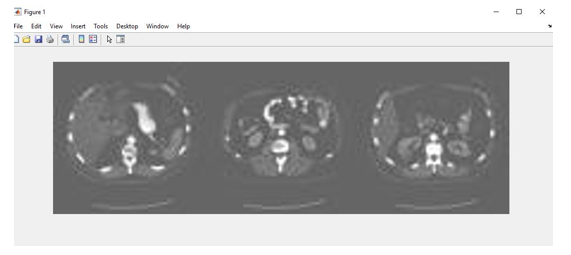
Figure 8: Output of simulation (picture of class 2 image)
(Source: MATLAB)
Appendix 8:

Figure 9: Structure of neural network
(Source: MATLAB)
Appendix 9:
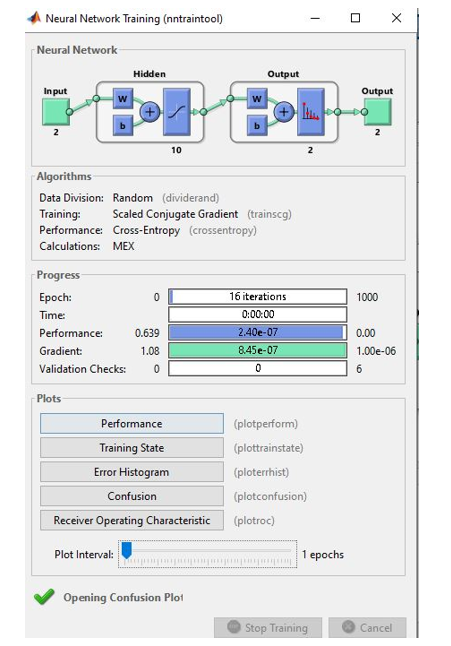
Figure 10: Output of simulation (Platform of training)
(Source: MATLAB)
Appendix 10:
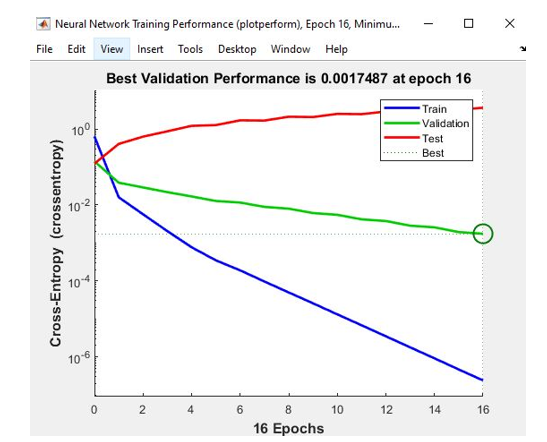
Figure 11: performance
(Source: MATLAB)
Appendix 11:
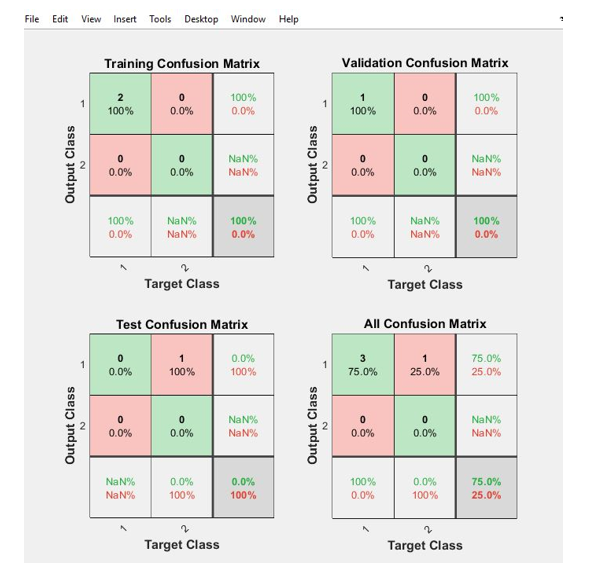
Figure 12: Confusion matrix
(Source: MATLAB)
Know more about UniqueSubmission’s other writing services:

